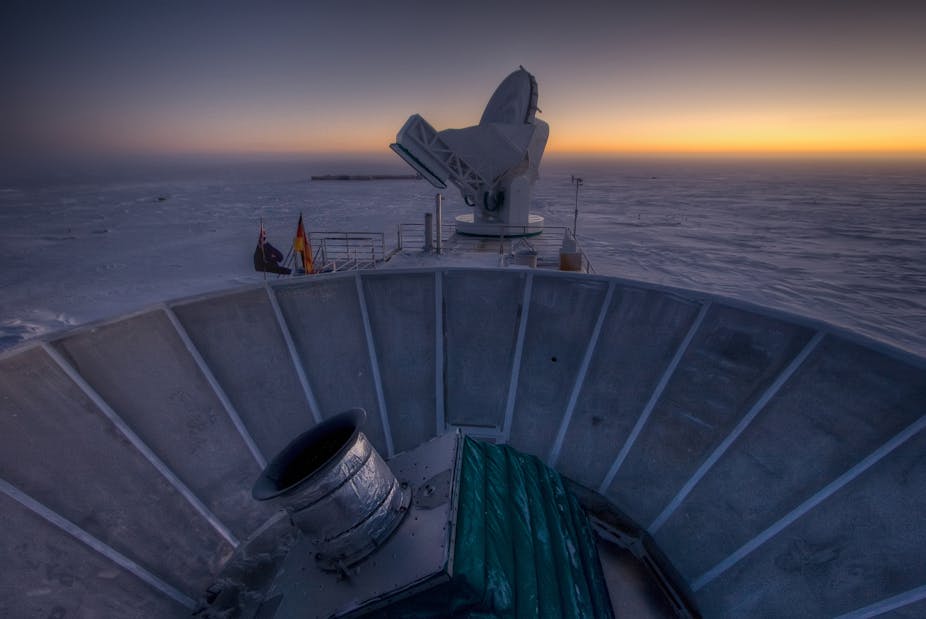The cosmological community is bubbling with the news that the BICEP2 experiment may have detected gravitational waves through measuring the radiation left over from the big bang.
If the findings are correct, we will have the most convincing evidence to date that very early on, the universe experienced a phase of extremely rapid expansion known as “inflation”, during which a very small region was stretched to an enormous size, becoming bigger than our observable universe.
We’ll also have a direct window into understanding particle physics at incredibly high energies and, in particular, the period of “grand unification”. This is far beyond what is possible to probe in particle experiments like the Large Hadron Collider at CERN.
The big bang model says our universe is expanding and, as it does, it is slowly cooling down. Turning back the clock, this means that when the universe was much younger, it was also much hotter. The cosmic microwave background, which BICEP2 was probing, is radiation left over from this hotter epoch and provides the best evidence we have that the big bang actually happened.
But while the big bang model has been confirmed in many different ways, it is not a complete theory and leaves many questions unanswered. One of the biggest of these questions is how things started, and why some parts of space were filled with marginally more or less matter than others.
We know from looking at the microwave background that the Universe used to be very smooth. In 1992, the COBE satellite discovered that there were slight variations in density when the universe was a few hundred thousand years old, but the differences in density were minute, only one part in one hundred thousand. COBE also showed coherent structures over distance scales that, according to the big bang theory, were much too large. Since the big bang began, there shouldn’t have been time for such large structures to exchange signals and find a common density.
Cosmic inflation
In the early 1980s, several models arose that could solve this problem. These models proposed that when the universe was much less than a second old, it experienced a period of accelerated expansion, a process known as “inflation”. During this accelerating period, quantum fluctuations naturally arose on small scales and were stretched to the size of our observable universe, effectively generating the seeds of structure seen by the COBE satellite.
One of the unique predictions of inflation models was that these quantum fluctuations weren’t restricted to ordinary matter but also occur in the gravitational fields where they manifest as gravity waves or gravitational radiation.
The evidence for a period of inflation has been building recently, including results reported by the European Space Agency’s Planck satellite last year, which showed that the amplitude of the initial seeds depends on the physical scale that you look at. But it has been said that the true smoking gun that inflation occurred lies in the gravitational waves, and this is why so much excitement has been generated by the announcement of BICEP2.
Detecting gravitational radiation not only shows that inflation happened but also indicates quite well what the temperature of the universe was when it happened. This appears to fit into the “grand unification” energy scale, when the electric, magnetic, weak nuclear and strong nuclear forces all unified into a single theory. It even gives us further indirect evidence that gravity waves actually exist, though they have yet to be directly seen.
Reasons to be cautious
BICEP2, a predominantly American experiment based at the South Pole, discovered the gravity waves by studying the signals that come from the microwave background. Light from the microwave background is expected to be linearly polarised, just as sunlight is when reflected off a flat surface, and this provides an extra degree of freedom that can’t be measured from its temperature.
It turns out that this new degree of freedom, which can be right or left handed and is known as “B-modes”, provides a direct channel through which to detect gravity waves. BICEP2 detected this pattern for the first time on large scales where gravity waves should dominate. While cosmologists are understandably excited by the result, there are many reasons to be cautious.
One major concern is that this result seems to be in tension with a limit published last year from ESA’s Planck satellite. Using another less direct technique, Planck put an upper bound which is apparently in conflict with the BICEP2 detection. Another concern relates to other astrophysical signals, such as from our own galaxy, which might provide foregrounds which appear as gravity waves. The BICEP2 team has made a strong case that these foregrounds should be small, but the experiment is limited in its ability to discriminate such signals if they exist.
On the other hand, if the BICEP2 results hold up, the implications are truly remarkable. They not only tell us how the universe came to be what it is just a fraction of a second after the big bang, but also open a new window into particle physics and our understanding of how the fundamental forces of the universe are related.

